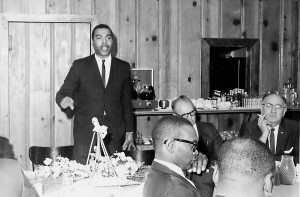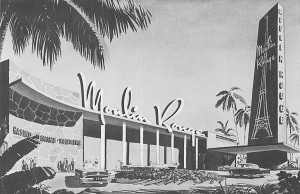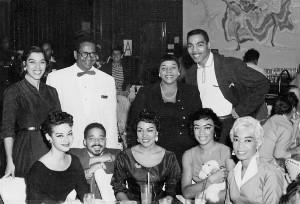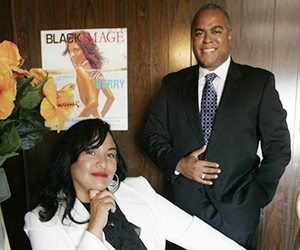Historic black Las Vegas and the civil rights era
February 1, 2009 by 09dgozd
Filed under Community, Cover Story, Feature
By Kimberly Bailey-Tureaud

Activist Bob Bailey, here speaking at a meeting on civil rights in 1963, was one of many on the front lines of the movement in Las Vegas during that era.y Kimberly Bailey-Tureaud
The lights of equal rights were dim in Las Vegas for black people during the civil rights era. This Black History Month marks another moment when we reflect on our history as a collective African- American people. Many of us who reside in Las Vegas might not be aware of the local trailblazers and activities that contributed in making equal rights in Las Vegas a reality.
This reality is one that many are benefiting from today with public accommodations, employment in the hotel and casino industry, elected leadership positions and business ownership. The legacy is our motivator and serves as our thank you for what was endured to ensure African-Americans’ freedoms in the entertainment capital of the world.

The Moulin Rouge was the site for the historic 1960 meeting to head off a planned civil rights march on the Las Vegas Strip.
Local African-Americans and some nonminority supporters fought to get the Jim Crow discrimination stain out of the fabric of Las Vegas from 1960 to 1969. The shadow of that stain is not totally invisible today, but we celebrate the tremendous strides that have propelled many over the road blocks of discrimination.
A momentous meeting at the historic Moulin Rouge in 1960 to head off a planned march led by the local NAACP on the Las Vegas Strip, marked the day when civil rights for black people was recognized by Nevada’s power brokers.
Previously, to simmering the African- American temperament from the boiling point of a march on the Strip, was a long and endured pounding of discrimination activities. These activities were blatant, overt and denied black people equal access to eat where you wanted to eat, live where you wanted to live, work where you desired to work and enjoy the entertainment luxuries Las Vegas offered.

Dinah Washington (seated center), shown in this 1955 photo with friends and fellow entertainers, was one of the many performers to be a headliner at the historic Moulin Rouge during a time when segregation was the norm in Las Vegas.
The historic meeting at the Moulin Rouge was called by Strip hotel and casino spokesman Hank Greenspun, a liberal and friend of the black community. Their mission was to meet with leaders of the Las Vegas black community and members of the local NAACP that was led by its president, Dr. James McMillan (Las Vegas’ first black dentist). Some of the other black community leadership at the meeting included: Dr. Charles I. West, Bob Bailey, attorney James Keller, Donald Clark and Woodrow Wilson, just to mention a few.
This meeting was the first to lead to a later structuring of the Consent Decree. That was an agreement for equal rights with the local Las Vegas Strip hotels, the NAACP and the U.S. Justice Department.
The Consent Decree was developed in November 1969 and outlined Las Vegas hotels and casinos’ commitment to have 12 percent employment opportunities to minorities in all positions of operation to be implemented within a three year period.
Many have attributed Josephine Baker’s actions at the Strip’s El Rancho in 1957 as another major turning point assisting in stomping out a mindset of racial discrimination in Las Vegas’ Strip hotels. Josephine Baker was looked upon more as a European celebrity and was booked at the famed El Rancho on the Las Vegas Strip.
Baker was very sensitive to the air of discrimination and noticed that there were no African-Americans in her audience where she was to perform. So, as a result she decided not to go onstage and perform until the El Rancho executives had African-Americans in the audience to view her performance. The local black community was rallied by community activists and African-Americans were seated for the first time in a Las Vegas Strip hotel & casino showroom to see Baker as her special guests.
Some of the other trailblazing black women such as Ruby Duncan rallied 300 black welfare mothers in the 1960s to march on the Las Vegas Strip that made it possible to get proper funding for social programs benefiting low-income black women.
The Rev. Marion Bennett, serving as an activist for economic benefits to the African-American community, also left his handprint as a significant member for social equal rights change. Dr. Bob Bailey served as chairman of the Equal Rights Commission from 1961 to 1964. He served to identify for then-Gov. Grant Sawyer and the Nevada legislative body racial discrimination practices and activities in the state of Nevada and report to the local government to what level discrimination was “officially” practiced.
Bailey’s report gave evidence of statewide practices of discrimination, and in 1964 the Equal Rights legislation was passed into law that gives all minorities in Nevada equal rights and opportunities in public accommodations, employment and housing.
According to Bailey, “Gov. Sawyer signed into law legislation, passed by the Nevada legislature that mirrored the guarantees afforded all citizens under the Constitution of these United States. That legislation became the bedrock for further legislative guarantees on housing, education, gender protection. As Nevadans, we can be proud of our progress, but let us not allow our progress to lull us back into apathy, for there is still much work to be done to fully achieve our goals of individual and collective freedoms along with emphasis on strong family ties.”






There may be noticeably a bundle to learn about this. I assume you made sure nice factors in features also.
Good article! We will be linking to this particularly great article on our website. Keep up the good writing.
I just want to mention I am just very new to blogs and absolutely loved you’re web page. More than likely I’m likely to bookmark your website . You actually have good articles. Thank you for revealing your website page.